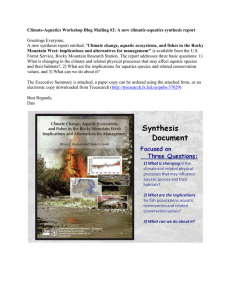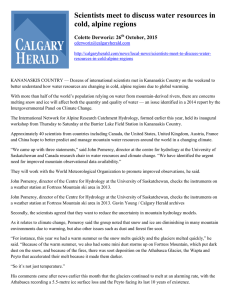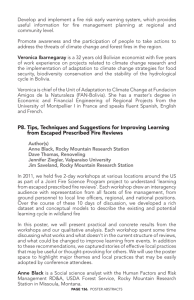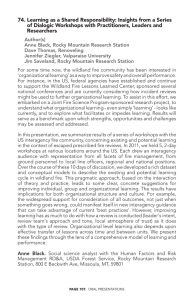News K-Country ridge guards treasures trove of data
advertisement
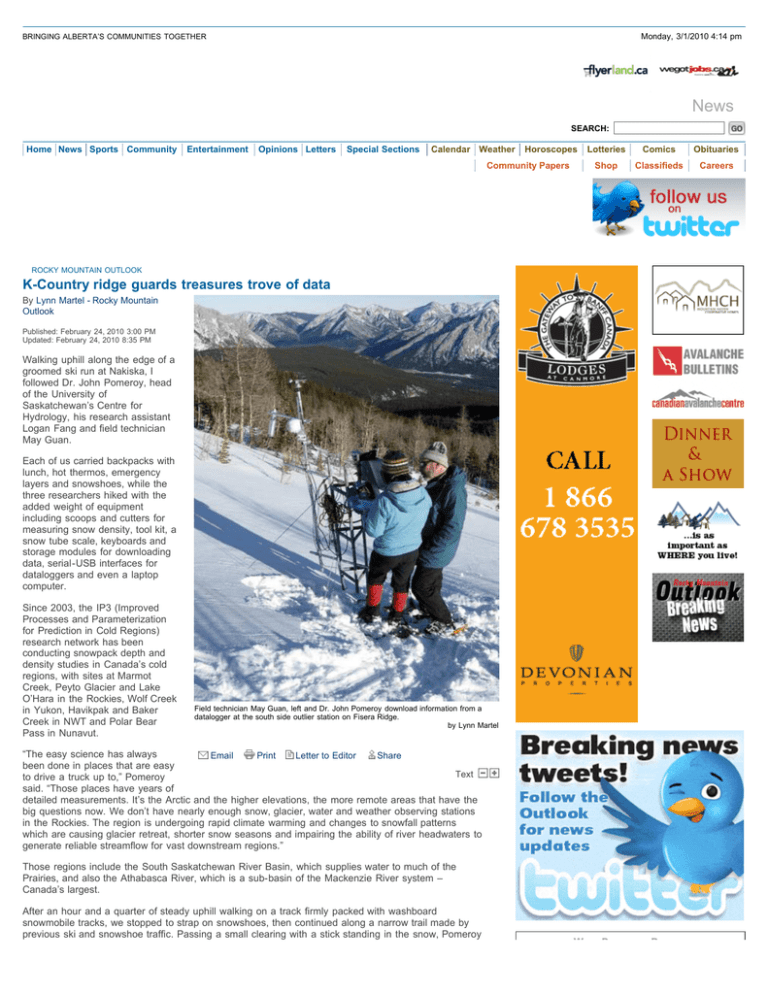
Monday, 3/1/2010 4:14 pm BRINGING ALBERTA’S COMMUNITIES TOGETHER News SEARCH: Home News Sports Community Entertainment Opinions Letters Special Sections Calendar Weather Horoscopes Community Papers Lotteries Comics Obituaries Shop Classifieds Careers ROCKY MOUNTAIN OUTLOOK K-Country ridge guards treasures trove of data By Lynn Martel - Rocky Mountain Outlook Published: February 24, 2010 3:00 PM Updated: February 24, 2010 8:35 PM Walking uphill along the edge of a groomed ski run at Nakiska, I followed Dr. John Pomeroy, head of the University of Saskatchewan’s Centre for Hydrology, his research assistant Logan Fang and field technician May Guan. Each of us carried backpacks with lunch, hot thermos, emergency layers and snowshoes, while the three researchers hiked with the added weight of equipment including scoops and cutters for measuring snow density, tool kit, a snow tube scale, keyboards and storage modules for downloading data, serial-USB interfaces for dataloggers and even a laptop computer. Since 2003, the IP3 (Improved Processes and Parameterization for Prediction in Cold Regions) research network has been conducting snowpack depth and density studies in Canada’s cold regions, with sites at Marmot Creek, Peyto Glacier and Lake O’Hara in the Rockies, Wolf Creek in Yukon, Havikpak and Baker Creek in NWT and Polar Bear Pass in Nunavut. Field technician May Guan, left and Dr. John Pomeroy download information from a datalogger at the south side outlier station on Fisera Ridge. by Lynn Martel “The easy science has always Email Print Letter to Editor Share been done in places that are easy Text to drive a truck up to,” Pomeroy said. “Those places have years of detailed measurements. It’s the Arctic and the higher elevations, the more remote areas that have the big questions now. We don’t have nearly enough snow, glacier, water and weather observing stations in the Rockies. The region is undergoing rapid climate warming and changes to snowfall patterns which are causing glacier retreat, shorter snow seasons and impairing the ability of river headwaters to generate reliable streamflow for vast downstream regions.” Those regions include the South Saskatchewan River Basin, which supplies water to much of the Prairies, and also the Athabasca River, which is a sub-basin of the Mackenzie River system – Canada’s largest. After an hour and a quarter of steady uphill walking on a track firmly packed with washboard snowmobile tracks, we stopped to strap on snowshoes, then continued along a narrow trail made by previous ski and snowshoe traffic. Passing a small clearing with a stick standing in the snow, Pomeroy WHAT PEOPLE ARE READING explained how the Twin Creeks groundwater observation site was part of the Marmot Creek studies that were conducted between the 1960s and 1980s by the Canadian Forestry Service and Natural Resources Canada. Minutes later, our packed trail ran out and, with the stamina of the Bow Valley’s top athletes, Fang forged ahead, not slowed by the 1.2-metre, 10-centimetre diameter hollow snow density measuring tube he carried in his hand as he broke trail in the knee-deep, sugary eastern slopes Rockies snowpack. Winding around bushes, stepping over logs and ducking under deadfall blocking the trail like shoulder-high hurdles, we occasionally stopped to relocate the barely visible dent in the snowpack that marked the way. “The first trip up after Christmas is always the toughest,” Pomeroy said. “A few more trips and we’ll have a highway.” Sure, albeit a highway navigable only by snowshoes that goes uphill for a steady 800 metres. As an avid mountaineer with considerable off-trail experience, I decided this was no beginner’s snowshoeing trail, but a first-rate test of mountain fitness that would not be fun for anyone unaccustomed to hauling a backpack up mountainsides. I found myself chuckling at the thought of climate change deniers so gleefully firing off letters to the editor accusing “Climategate” scientists of fudging research data for the reward of increased funding. No amount of funding, I concluded, would motivate any person to endure such a slog. While mountaineers push themselves up treadmill scree in pursuit of a summit, and backcountry skiers climb for hours for the fleeting reward of untracked powder turns, Pomeroy and his team will enthusiastically make this ascent repeatedly throughout the remainder of the winter for the simple reward of recording wind and precipitation data. Fisera Ridge is named for Denny Fisera, who, through the 1970s, hiked up here every few days to check on dozens of hydrometric research sites run by the Canadian Forestry Service. Finally reaching treeline three and a half hours after leaving the parking lot, Pomeroy checked the readings on a weighing Geonor snow/rain gauge that resembled a two-metre tall amusement park giant swing ride. The temperature read -3.5 C, the wind was blowing three metres per second from the south, humidity was 60 per cent. An aluminum ladder was propped against a tree, its base firmly buried in the snow. Most years, Pomeroy said, the snowpack would become so deep that they’d need the ladder to access the gauge. Continuing along the windswept ridge, Fang and Guan walked a transect line, measuring the snow depth every five metres and every 20 metres, recording its weight using the snow tube Fang carried up and a spring scale specially calibrated for the purpose. The deepest snow was 159 centimetres, the shallowest two centimetres. We moved on to a smaller station on the north side of the ridge, then to one on the south, where the researchers plugged in USB cables and downloaded data. The information recorded gives them the ability to calculate the snow water equivalent (SWE, pronounced swee), the depth of water that would be standing if the snowpack were transformed to liquid water – or the equivalent depth in rainfall. “The trick was to keep a solar panel here that wouldn’t blow away,” Pomeroy said. “We had some disasters at first. The first one was attached to two sections of T bar – that’s what cattle ranchers use. It got bent over by the wind. I’ve never seen that!” The winds on Fisera Ridge regularly reach 150 kilometres per hour. The stunted, beaten krumholtz are evidence of that. Hanging at the far end of a steel pipe arm, two domes called radiometers measure solar radiation and thermo infrared radiation, both what’s coming in and going out. An ultrasonic snow depth gauge bounces a signal off the snow to record its depth. “It works like a range finder in an old Polaroid camera,” Pomeroy explained. It also measures soil temperature, soil moisture and snow temperature. Each instrument on the metal frame is wired into a data logger, a computer with a series of ports which applies voltage to the instruments for a few milliseconds and measures what comes back, in a manner similar to a volt meter. Measurements are taken every 10 seconds, saved up in the datalogger memory, averaged and then stored in the datalogger permanent memory every 15 minutes. Once a day the datalogger downloads data to awebsite via a telemetry system. The data goes through a modem to a radio which sends the numbers to a radio attached to another datalogger in a clearing at the Marmot Creek upper clearing site lower on the mountain, then is sent via a cell phone as digitized info to an IP site. The raw data can be read from a computer in Saskatoon, where Pomeroy was based at the U of S campus until relocating to Canmore last July, to be closer to his research sites. Remote sites such as this require regular and frequent monitoring. When an anemometer measuring wind speed recently stopped transmitting data from its perch on the roof of the Alpine Club of Canada’s Bow Hut, someone had to ski up to find out a wire was broken. The computer in Saskatoon puts the data on a website, http://www.usask.ca/hydrology/ Pomeroy checked it before we hiked up that morning. Encased in a separate black box, a time lapse camera is triggered by the data logger to take two photos per day - one in late morning, one early in the afternoon - of the snow covered area in the WHAT PEOPLE ARE READING Brooklyn, NY arrived from news.search.yahoo.com reading www.albertalocalnews.com - NBC cuts ceremonies to air new show Calgary, Canada arrived from google.ca reading Rocky Mountain Outlook - Glaciologist’s presentation to highlight Yukon research Renton, WA reading Red Deer Advocate - Sting nets record haul of electronics, discs 4 users from Canada reading Red Deer Advocate - Your Best source for Local Community News delivered in print or online Red Deer, Canada arrived from albertalocalnews.com reading Red Deer Advocate - RCMP on the hunt for missing youth with medical condition Willowdale, Canada arrived from grab this · news blog cirque below Mount Allan’s summit. “We’re interested in the snow covered area,” Pomeroy said. “During the snowmelt, that tells us how much of the basin is melting and contributing to the stream flow. It’s most important in May, June, July. This is the least amount of snow I’ve ever seen in all the years I’ve been coming here. We could be looking at the D-word – drought.” After only about 90 minutes at the site, the sun dropped below the ridgeline a few hundred feet above us. “Time to get the heck out of Dodge,” Pomeroy said, packing up. “Once the sun goes down, it gets ugly up here.” I don’t doubt it, and he’s got the data to prove it. Even going downhill, it takes a full two hours to hike quickly back to the parking lot. No summit tagged, no fresh powder turns, no retention incentives, no performance bonuses. Just another tiny drop in the stream of hydrological research. Most Read Stories This week | Last week Alberta grizzly population “shockingly” low Rocky Mountain Outlook • Feb-17-2010 Climate change risk more than just a few degrees Rocky Mountain Outlook • Feb-24-2010 At the rate we’re going, all we’ll have left is photos Rocky Mountain Outlook • Feb-17-2010 Canmore more than weekend homes Rocky Mountain Outlook • Feb-24-2010 K-Country ridge guards treasures trove of data Rocky Mountain Outlook • Feb-24-2010 McKeever's Olympic hopes dashed at last minute Rocky Mountain Outlook • Feb-27-2010 Lack of new construction to affect Bow Valley real estate market Rocky Mountain Outlook • Feb-172010 Parks moving to restore Cascade pit Rocky Mountain Outlook • Feb-17-2010 Ice climber rescued from Cascade waterfall Rocky Mountain Outlook • Feb-17-2010 Dusk to dawn closure no brainer Rocky Mountain Outlook • Feb-24-2010 Photo radar creates new millionaire Rocky Mountain Outlook • Feb-24-2010 Culvert facelifts to improve fish movement Rocky Mountain Outlook • Feb-17-2010 Town seeks to take on care of aging willows Rocky Mountain Outlook • Feb-24-2010 Installation seeks to capture feel, memories of The Diner Rocky Mountain Outlook • Feb-24-2010 Ice Art Rocky Mountain Outlook • Feb-24-2010 more local news from around AB » About Us Advertise Contact Us Terms of Use RSS Community Papers © Copyright . All rights reserved.

